Yokohama Mitsui Building to House One of the World's Largest Model Railway Museums
Hara Model Railway Museum to Open on Tuesday, July 10, 2012
May 24, 2012
Mitsui Fudosan Co., Ltd.
Mitsui Fudosan Co., Ltd. has announced that it will open the Hara Model Railway Museum on Tuesday, July 10, 2012 on the 2nd floor of the Yokohama Mitsui Building (Takashima 1-chome, Nishi-ku, Yokohama City, Kanagawa). The Yokohama Mitsui Building was completed in February 2012 in the Minato Mirai 21 area.
The Hara Model Railway Museum houses a display of approximately 1,000 model trains selected from the collection of Nobutaro Hara, a world-famous railway model creator and collector. One exhibit from this collection will display gauge one model trains running on one of the world's largest indoor dioramas (approx. 310 m2), called the “Ichiban Tetsumo Park Diorama.”
Numerous rare items from the collection will also be displayed. Highlights include installation of the Yokohama Diorama depicting the cityscape of Yokohama and running HO gauge* model trains. Other items on display will include replicas of the first ticket ever issued for the Tokaido Shinkansen and rare antique toy trains.
The Hara Model Railway Museum preserves the historical memory of Yokohama as the first area in Japan to open railroads. The museum will provide a venue for international cultural exchanges and festive gatherings where visitors can learn more about the history and culture of industry through the world's model railways. In these ways, the Hara Model Railway Museum will contribute to the further cultural and economic development of Yokohama City.
Operational Overview
| Opening |
July 10, 2012 (Tuesday) |
| Operating hours |
11:00 to 18:00 (last entry at 17:30) |
| Days closed |
Tuesdays (if Tuesday is a national holiday, the museum will be closed on the next business day; open on July 17)
Year-end/New Year holidays (December 31 to January 2)
Exhibit maintenance and inspection period (scheduled for five days in early February)
* In its first year of operation, the museum will be open on all days in July and August 2012 and during the Golden Week holidays (early May). |
| Entrance fees |
Adults: ¥1,000
Junior high and high school students: ¥700
Children (four and older): ¥500
(all prices include consumption tax) |
| Ticketing |
Please purchase tickets upon entry at the museum. |
| Contact |
+81-45-640-6699 (Hara Model Railway Museum Opening Preparation Office; weekdays from 11:00 to 18:00) |
| WebsiteHP |
http://www.hara-mrm.com/english/index.html
(The latest information about the museum, operations and other details will be posted regularly on the website.) |
* The foregoing operational overview is subject to change. Please visit the museum website to confirm the latest details.
** The museum has changed the ticketing method from that announced in the press release issued May 24, 2012.
Special advance reservation days have been cancelled, and all tickets will now be sold upon entry. (June 20, 2012)
1. Nobutaro Hara's Fascinating Model Trains
Model trains that faithfully recreate the details of real trains
One of the features of Mr. Hara's models is that they faithfully recreate the details of real trains. These fascinating models embody advanced workmanship and Mr. Hara's unwavering dedication to quality. Among their many fascinating aspects the following three features are especially noteworthy.
Three Main Features of Nobutaro Hara's Model Trains
Realistic running sounds from iron wheels on iron rails
In general, the rails and train wheels of model railways are made of easily malleable materials such as brass, which is an alloy of copper and zinc. However, Mr. Hara's models use iron rails and wheels, just like real railways and therefore produce the same sound as real trains as the wheels rub against the rails and when the trains go over the joints between track sections.
Advanced Workmanship Enables Coasting of Model Trains
Coasting refers to running a train solely on the inertia it gains from motor-driven acceleration, by cutting off power to the motor after the train has accelerated. Mr. Hara pioneered the coasting of model trains. Currently, there are only a few common model trains that can coast. Mr. Hara enabled model trains to continue coasting after cutting off power to controllers by rigorously modifying the gears and other parts used in the their transmission systems (the system that transmits the motor's torque to the wheels). After model trains speed up, the sound of the motor stops, leaving only the “click-clack” sound of the wheels as they cross the junctions in the tracks. The reverberation of this sound in the room without any motor noise is one source of the fascinating sound of railways.
An Authentic Look: Model Trains Drawing Power From Overhead Lines
Generally speaking, model trains are powered by electricity drawn from the rails. Mr. Hara's models, however, draw power from overhead lines via a pantograph. Advanced knowledge and workmanship are needed to develop a mechanism for drawing power from overhead lines. For this reason, they are hardly ever used in model railways in Japan. Moreover, visitors can enjoy the authentic look of model trains as their pantographs expand and contract as they track the overhead lines.
2. Museum Overview
| Name |
Hara Model Railway Museum |
| Location |
2F Yokohama Mitsui Building, 1-2 Takashima 1-chome, Nishi-ku, Yokohama City, Kanagawa |
| Floor space |
Approx. 1,700m2(gross floor area) |
| Access |
JR Yokohama Station (5 minutes on foot)
Minato Mirai Line Shin Takashima Station (2 minutes on foot)
*No parking is available at the museum. Please use public transportation or paid parking at or near Yokohama Mitsui Building. |
Details of facilities
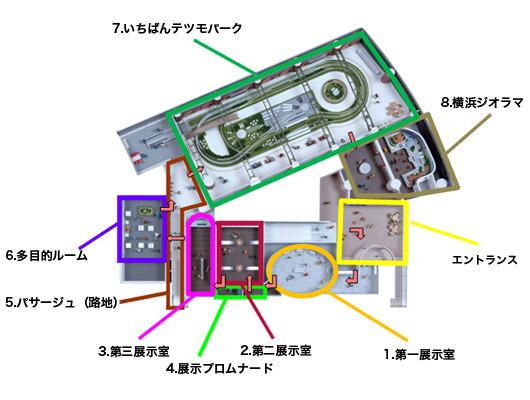
-
First Exhibit Room “The Essence of Hara Models”
The First Exhibit Room displays unique model trains carefully chosen from among Mr. Hara's collection and his original creations. Precious model trains are displayed, such as the first original model train built by Mr. Hara, and a Kongosan Electric Railway railcar, which ran on the Korean Peninsula prior to World War II. Others include the Orient Express, which ran from Paris to Istanbul, and a pre-war Hakone Tozan Railway railcar, which is intricately crafted down to the finest detail, including the driver's seat, passenger seats and overhead shelves. Poster panels and videos explain the finer details of Mr. Hara's original model train creations and other topics in clear and simple terms.
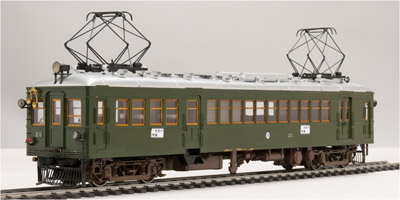
Kongosan Electric Railway No.22 EMU
This Kongosan Electric Railway railcar ran on the Korean Peninsula before World War II. It was made of steel, which was rare at the time, and was able to operate in mountainous areas with steep gradients.
(Gauge one)
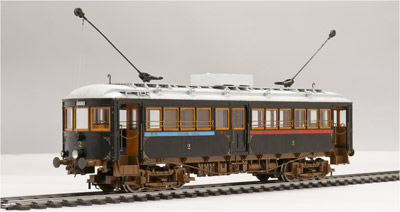
Hakone Tozan Railway Chiki Series (Chiki No.1)
This railcar entered service in 1919, the year Mr. Hara was born. It was a wooden railcar newly built to climb the steep gradients of the Hakone Tozan Railway.
(Gauge one)
-
Second Exhibit Room “Storytelling Models”
The Second Exhibit Room displays European, U.S., and Japanese steam and electric locomotives, and railcars with scales of O gauge* or larger.
Exhibits are displayed by theme, allowing visitors to explore the culture and history of individual eras through the models.
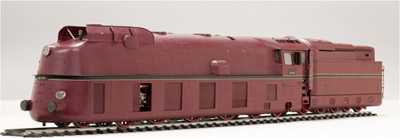
DB DR05 001DB DR05 001
German steam locomotive
(Gauge one)

NSWGR AD 60 Class 6020
Australian steam locomotive
(Gauge one)
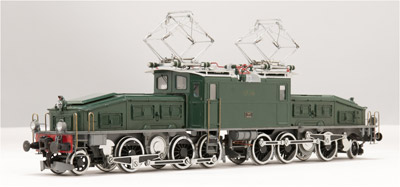
SBB Ce6/8 14284
Swiss electric locomotive
(O gauge)
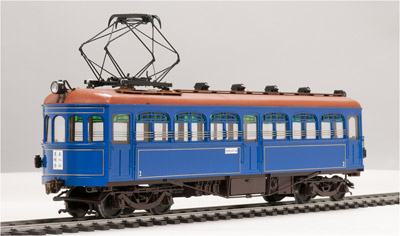
Osaka Railway Day 1 Class 2
Japanese pre-WWII railcar
(Gauge one)
“Legend of Shangri-La”
This exhibit features large photographs of Hara's own "Shangri-La Railway Museum" (built in his home; not open to the public)
-
Third Exhibit Room “Vintage Collection”
This part of the exhibition features replicas of Mr. Hara's extensive collection of first tickets (first tickets issued for a new train) as well as rare antique railway toys. The collection includes first tickets for the Hikari Tokaido Shinkansen and for the Izu Kyoko Line express and tells the stories of how they were collected. Other interesting personal exhibits include Mr. Hara's solo travels through the Kansai area as a child, his travels through the Korean Peninsula and Northeast China (formerly Manchuria) prior to WWII, and his travels around the world after the war. The display includes rare cameras and records from these periods.

First Tickets
(Tokaido Shinkansen)
-
Exhibition Promenade “Nobutaro Hara and Japan's Railway History”
This exhibit shows a chronology of the achievements of Nobutaro Hara, together with a chronology of the history of railways.
-
Passage “HO Gauge Models”
The walls of the passage feature an exhibition of the HO gauge* models owned by Mr. Hara. Real railway plates and mass controllers are exhibited near the entrance of the Ichiban Tetsumo Park.
-
Multipurpose Room
This room is for special exhibitions and events. From July to September 2, the following events will be held.
Special Opening Exhibition-Perfect High-Precision Recreation of the FS E626 Electric Locomotive
This is an approximately 1/32 scale model of an electric locomotive built by the manufacturer Breda for the Italian national railway in 1928, faithfully re-created in detail not seen anywhere else in the world. The assembly of the model also mimics that of the real world, with the basic frame being constructed first, followed by the mounting of the roof, sides, and end panels. The model is made from nickel silver, and has no solder at all, being constructed entirely with rivets and screws. All external facing doors can be opened and closed, and inside the train is a lever-operated opening and closing mechanism. All parts of the model have the same construction and manufacture as the real train. For example, when the manual-operated brake wheel in the driver's cockpit is turned, it winds a chain that simultaneously operates the brakes on all of the railcars. The model is fitted with internal air compressors, motor cooling fans, and electric motors. These are just some of the features that make this model such a faithful replica of the original. The pantograph alone comprises 650 components, and the entire model is made up of some 9,000 parts. The model is not only a fantastic example of mechanical engineering, but a beautiful work of art.
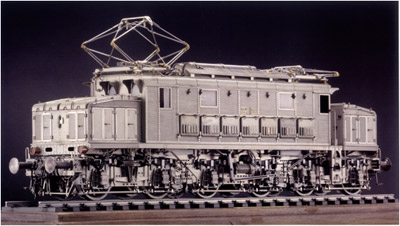
FS E626 Class Electric Locomotive
Italian electric locomotive
(Gauge one)
-
“Ichiban Tetsumo Park”
Here Mr. Hara's models run on one of the world's largest indoor dioramas running gauge one models at approximately 301 m2. The diorama is approximately 70 m in circumference, and features six rail lines with a total length of about 450 m. The scenery is modeled on Europe, in keeping with Mr. Hara's trademark style of matching the scenery with models from around the world. The stationhouse alone is approximately 5 m in length, and is inspired by Gare de Lyon in France. There are also plans for a display featuring U.S. Big Boy steam locomotives pulling over ten carriages.
Secret of Hara Models
Mr. Hara's models are packed with complex technical features and designs that cannot be observed from the outside. This exhibit provides easy-to-understand explanations about the technological details using panels, and also includes a recreation of the model studio in Hara's own home.
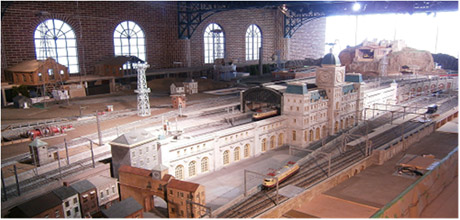
Ichiban Tetsumo Park Diorama under construction
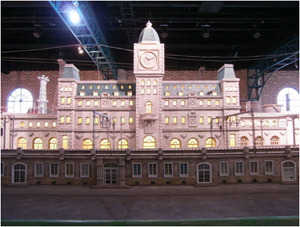
Stationhouse inspired by Gare de Lyon
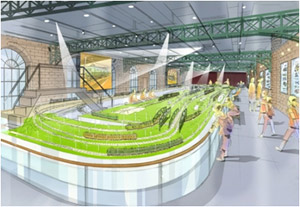
Ichiban Tetsumo Park (perspective drawing)
-
Yokohama Diorama
This diorama recreates the cityscape around Yokohama in the past with elements such as the scene around old Yokohama Station (present-day Sakuragicho Station) as well as Bashamichi and Chinatown areas. Up to five HO gauge railway models can run at the same time on the diorama.
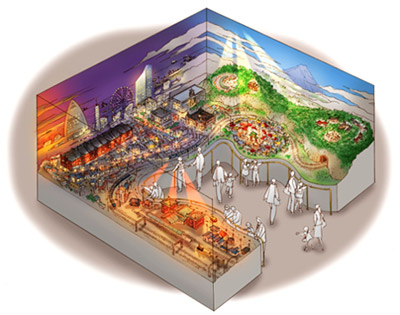
Yokohama Diorama (perspective drawing)
*O gauge rails are usually spaced 32 mm apart. The length of the railcars may vary with each engine, carriage and freight car, but is usually around 500 mm. (1/43 to 1/48 scale).
*HO gauge rails are usually spaced 16.5 mm apart. The length of the railcars may vary with each engine, carriage and freight car, but is usually around 200 mm. (1/80 to 1/87 scale).
*Gauge one rails are usually spaced 45 mm apart. The length of the railcars may vary with each engine, carriage and freight car, but is usually around 800 mm. (1/32 scale).
* The content of the exhibits is subject to change without notice.
3. Profile of Nobutaro Hara
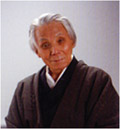 Born in Shiba, Tokyo on April 4, 1919, Mr. Hara attended Keio schools from Yochisha Elementary School through to Keio Senior High School before entering the Department of Mechanical Engineering and Science at Tokyo Institute of Technology to study railway technology. He was conscripted into the military after graduation.
Born in Shiba, Tokyo on April 4, 1919, Mr. Hara attended Keio schools from Yochisha Elementary School through to Keio Senior High School before entering the Department of Mechanical Engineering and Science at Tokyo Institute of Technology to study railway technology. He was conscripted into the military after graduation.
After World War II, Mr. Hara was in charge of development and technology at stationery company KOKUYO Co., Ltd. where he was involved in automation development. While at KOKUYO, he developed technologies that were to help define his era, as well as contributed to the company. These included the world's first multi-tier automated warehouse and a fully automated manufacturing line for office furniture. After serving as executive director and as president of a production affiliate, Mr. Hara finally retired from KOKUYO as a corporate advisor.
At retirement, he donated to KOKUYO more than 300 technical patents that he had applied for or held personally. Mr. Hara used his retirement allowance to found The Hara Research Foundation to support a new generation of scientific and technical researchers. Currently, he serves as chairman of that foundation and as an honorary trustee of the University of San Francisco.
Mr. Hara's love of railways started when he was very young. He was collecting the first tickets issued for certain trains and making long trips, camera in hand, while in elementary school. In an era when not everything could be found on a store shelf, Mr. Hara made his first model at age 13. And he learned German and French so he could read books on railway technology. Throughout the turbulent years during and after the World War II, and during Japan's recovery and high-growth period, Mr. Hara always maintained his interest in railways and technology. He has traveled around the world, creating and collecting models. To date, he has visited 380 countries and has a collection that encompasses approximately 6,000 model train cars, 100,000 still photos, and 440 hours of film. Mr. Hara has also collected many railway books and related items. Even today, his vast collection is still growing.
Author of: Hara Nobutaro Tetsudo Mokei no Subete (All about Nobutaro Hara's Model Railways), Seibundo Shinkosha Publishing Co., Ltd. and Super Tetsudo Mokei Waga Shogai Doraku (Super Model Railways: My Lifetime Hobby), Kodansha Shinsho
4. Location
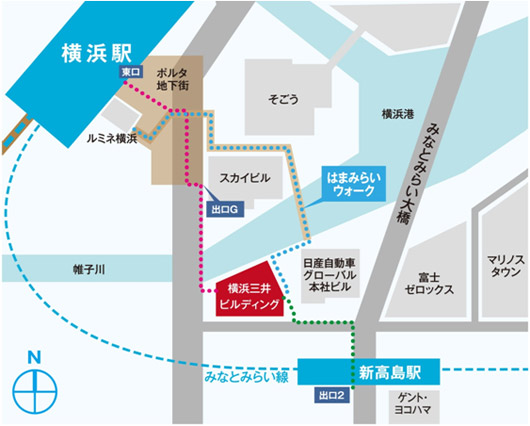
2F Yokohama Mitsui Building, 1-2 Takashima 1-chome, Nishi-ku, Yokohama, Kanagawa Prefecture
JR Yokohama Station (5 minutes on foot)
Minato Mirai Line Shin Takashima Station (2 minutes on foot)